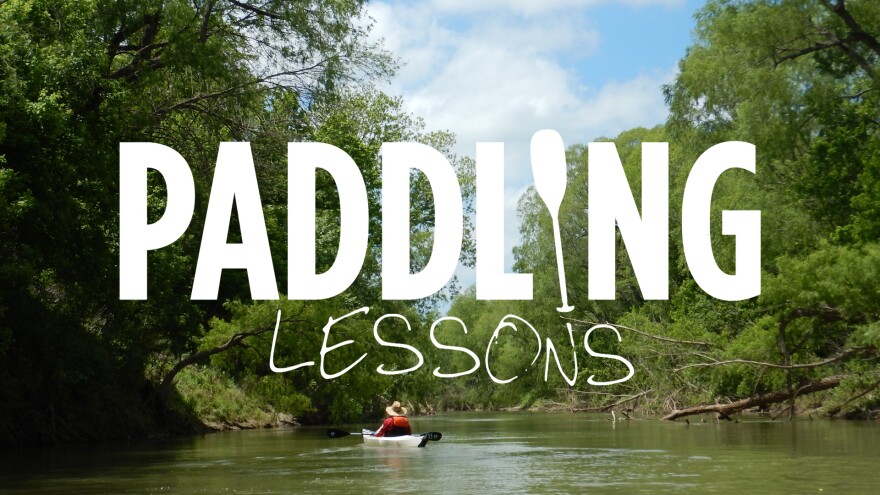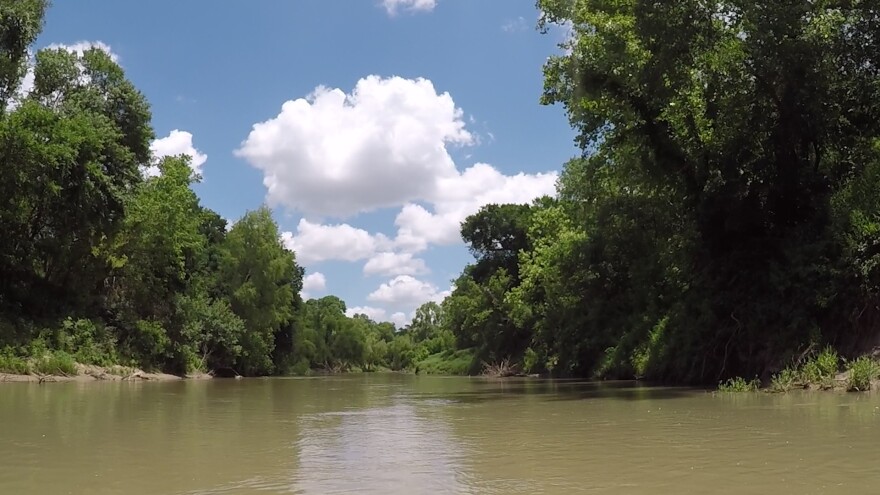“So many folks locally, and worldwide, only know the San Antonio River Walk. I was really trying to look for and capture those interesting things that might tell a bigger deeper story about the river,” explains Steven Schauer.
Schauer, who has worked at the San Antonio River Authority for over 12 years, set up his own shingle, Studio Schauer, to document the hidden reaches of the river in a new film, “Paddling Lessons,” that premieres at 2:00 p.m. this Sunday at the San Antonio Film Festival. The screening takes place in the Tobin Center’s Feik Family Rotunda.
TPR’s Nathan Cone invited him into our studio to share some of his discoveries in advance of the premiere. This interview has been edited for content and clarity.
https://vimeo.com/347408803">Paddling Lessons Trailer from https://vimeo.com/studioschauer">Steven Schauer on Vimeo.
Nathan Cone: Your professional life as the Director of Government and Public Affairs at the San Antonio River Authority helped influence the desire to make this film, but what is your own relationship to outdoor life, paddling the river itself, that made you want to make the movie?
Steven Schauer: Well, I've always been outside. I was kind of raised out in state parks and national parks, and camping and swimming was something I just grew up with. So that's always been an interest of mine. This particular project-- what really sparked it was, I was reviewing films for the San Antonio River Authority's Environmental Film Fest back in April of 2016. I saw a wonderful short film called "Paddle for the North" about six guys, and two dogs, kayaking through northern Canada and Alaska. And after I watched that film, I was like, "I'm going to make a movie kayaking the San Antonio River." So that was really what inspired this process.
What is the furthest that you had gone yourself in in kayaking, paddling?
About 12 miles was about the furthest I had been in a paddling situation prior to making this. I'd really been more of a hiker, and a camper, not so much a kayaker. So I was relatively a novice when when this project started. I feel much more advanced now.
Well hence the title "Paddling Lessons!" So what concerned you most about making this journey?
Well, it's really going through some parts of the San Antonio River that are not traveled often if at all. So the biggest concerns I think I had was, was really logjams. We do have some paddling trails, the San Antonio River Authority, that is, that we operate. About 45 miles of paddling trails, and we try to keep those open. But when you're talking about 260 miles there's a whole room for a bunch of other things to happen along that stretch of river so logjams was my biggest concern when I started this project.
We see at least two of those in the film and there's a lot of debris in them as well which made me think that--and this is a very dumb question to ask, but what's the most common way that that trash gets in the river downstream from where we are in the city?
It's storm water runoff. People either misplace trash, or they don't put it in the right spot, or if they do, and a trash can gets filled and tipped over, then rains and wind will take that trash into the nearby creek, and all the creeks in the San Antonio River watershed eventually end up in the San Antonio River. So all of that trash that we see in there-- and I saw plenty of it on this trip-- really comes from us, the people that live here in the San Antonio area. Certainly as you get into the southern basin there's some local contributions there as well, but it's really this urban area of San Antonio. And if there could be one message out of this is, if folks could take a little bit better care of their trash, recycle things properly, throw things away properly, that would make a big difference for the for the wildlife and the beauty of the river.
How do things like those logjams get cleaned up along the river?
Well, a lot of the cleanup happens along the Mission Reach section of the San Antonio River Walk by the San Antonio River Authority. We clean up about a hundred and fifty thousand pounds of trash a year from just the Mssion Reach alone. So that's a considerable amount of trash that we pick up. As we get it down into the southern basin in Wilson, Karnes, and Goliad, the San Antonio River Authority has a debris removal program as well. So if there's a big logjam on somebody's property, we can come out investigate and figure out the best way to help that property owner clean up that debris pile.
So when you say property owners... I think we tend to think of the river as being the people's property, but when you say a logjam happens on somebody's property, how does that happen?
Well it's a great distinction-- the river itself is the people's waterway, it belongs to the citizens of the state of Texas. The challenge is getting access to it because the property along the river is private. So when there's a logjam on the river, that's the public river, if it's really in an isolated area of the river basin, it's difficult for the public to get to it. So that adjacent property owner is really what I'm referring to, is they can call the San Antonio River Authority and we can come out with permission to access through their property to get to the river and investigate that logjam and that debris pile and then figure out the best way to clean it up.

Back to the documentary itself. We mentioned before I turned on the microphone that it took several months to actually complete the documentary. It's not a single contiguous 245 miles, is that about what it was?
The trip itself was about 260 miles from the Blue Hole here in San Antonio all the way down to the dock at Sea Drift on San Antonio Bay. I did it over about 21 days. It wasn't a contiguous three-week trip, I spread those 21 individual day trips out over about a six, eight-month period and really broke it up into bite-sized chunks that could have been anywhere from six to eight miles all the way up to 17 or 18 miles per day.
So you had colleagues and partners there to give you the support along the way.
Absolutely. You never want to paddle by yourself. So I always had somebody with me and had a tremendous amount of ground support from the San Antonio River Authority as well, and helping to drop us off and pick us up at designated locations. Which, frankly along the southern basin was often a bridge right-of-way, either county roads or state highway roads, because it really is difficult to access the river down there. So we were scaling down and scaling up bridge right-of-ways often, to get in and out of the river.
I love some of the camerawork in the movie as you move along the water and you also have an aerial camera. So was that done using a drone I guess? Because there are gorgeous overhead shots.
Thank you for that! The drone work was done by some assistance provided by Victory Boulevard, and you see them as one of the folks that helped produce the film, along with the River Authority and Studio Schauer, so they provided all the drone shots. They weren't along every day, but where I could... it was really helpful to get that bird's eye perspective.
Early on in the film, and then of course later on as well, we see some wildlife in the river. Alligators! Was that a little nerve wracking?
You know, the shots that I got of the alligators particularly down in the southern basin... I was concentrating so much on not missing the shot, I didn't realize, you know, at one level how close I was actually kayaking to these wonderful creatures, but they are native to the river and folks often don't realize that. So they were they were at home there, and I was sharing their space.
Well working in your capacity in the San Antonio River Authority for as many years as you have, you have of course studied, you've lived with the idea of the San Antonio River and its health over these many years. Is there anything new that you discovered about the river through this journey from San Antonio all the way to the bay?
You know, it's much more beautiful than I even knew it was. And I've been working with the river and San Antonio River Authority now for over 12 years. A lot of what I do in my job is talk about the river, and talk about all the great work that the River Authority is doing. But getting out there and seeing some of these really isolated patches of the river first hand was was personally just very enjoyable and you know the falls down at Falls City, for example, it's just a beautiful series of waterfalls down in the southern basin that most folks don't even know is there. It's just really stunning and very beautiful. So it was just great to see a lot of these things that I'd heard about with my work but hadn't seen firsthand.
And as you're paddling along and in that kayak, what are you looking at most? What is the thing you you noticed most when you're out on the river?
Well for this film I was always looking for something kind of photogenic and nice to show, so I'd actually love to go kayaking again without a camera so I can just thoroughly just be at peace and enjoy that trip. But most of the time we were looking for those moments that you're mentioning, just things that people might not think of when they think of the San Antonio River. You know, we all know the River Walk and we love the River Walk, and it's a wonderful economic generator for our community. But so many folks locally and worldwide only know the San Antonio River Walk. So I was really trying to look for and capture those interesting things that might tell a bigger deeper story about the river.
"Paddling Lessons" premieres at 2:00 p.m. this Sunday, August 4th at the San Antonio Film Festival. The movie will screen in the Feik Family Rotunda at the Tobin Center for the Performing Arts.






